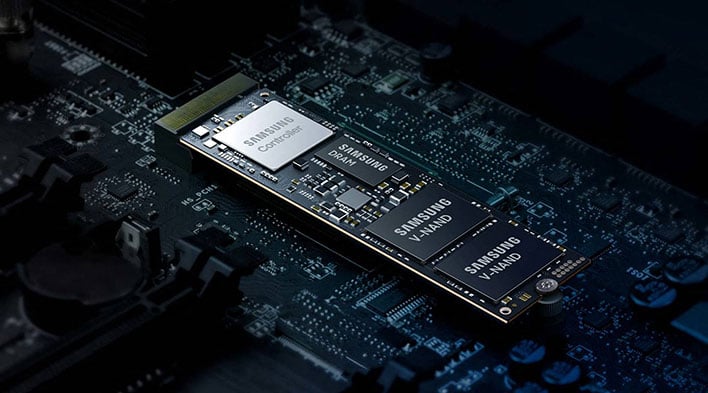Samsung's Roadmap Outlines PCIe 4.0 And 5.0 SSDs Leveraging 176-Layer V-NAND
Samsung finds itself in a braggadocios mood over the continued development of its vertical NAND flash memory chips, and in a blog post spanning nearly 1,400 words, the company talked about what makes it so special, and where it is headed. To that latter point, its 7th generation V-NAND flash memory chips are punching their ticket to both PCI Express 4 and, eventually, PCI Express 5.0 solid state drives.
The chest-thumping is not unwarranted. Three-dimensional (3D) chip stacking is what has enabled higher capacities on increasingly fast storage products, at acceptable thickness levels for today's electronic devices, like smartphones and PCs. It's pretty remarkable when you take a moment to think about how far storage has come over the past few decades.
To offer some perspective, Samsung likened NAND flash memory development to the ever-expanding universe we live in, for a sense of scale.
"If we were to view the history of the universe as one year, the existence of the human species falls stunningly short of 14 seconds before the end of this year. With more than 170 billion known galaxies constantly expanding, our Sun and the Earth are by no means at the center of our universe’s development. This same analogy can be applied to semiconductors," Samsung says.
"If you look at a semiconductor chip smaller than the size of a fingernail through an electron microscope, there lies an entire miniature universe. Despite its thickness of just 1mm, millions of carefully constructed spaces exist within a chip in order to store huge amounts of data," Samsung continues.
For a long time, the universe of NAND flash memory chips consisted of two-dimensional (2D) structures, with chips being scaled and laid onto flat surfaces. It worked well for a time, but there was a limit to how much storage could be crammed onto a compact 2D space. That is where 3D stacking comes into play (and not just in storage, but CPUs as well, like Intel's Foveros packaging).
Samsung brands its solution as V-NAND (vertical NAND). It consists of stacked layers with pierced holes, a concept roughly similar to a high-rise apartment complex. Samsung's first V-NAND solution consisted of 24 layers, and has since grown more than seven-fold, to 176 layers. This presented another challenge: the increasing height.
"Samsung contemplated and began to design solutions for the impending problem of V-NAND height before any other player in the semiconductor industry. The company’s 176-layer 7th generation V-NAND is similar in height to the industry’s 6th generation, 100+ layer V-NAND, an innovation made possible thanks to our successful development of the industry’s smallest cell size yet," Samsung explains.
The company says it managed to reduce cell volume by up to 35 percent by decreasing the surface area and height through 3D scaling technology, all while minimizing interference between cells. Samsung says it is the only industry player using single-stack etching technology capable of stacking 100 layers at once, interconnected through more than 1 billion holes. Incidentally, Micron has its own 176-layer NAND solution.
It has all led to Samsung's 7th generation V-NAND. Samsung says it nearly ready to showcase a consumer SSD based on its latest V-NAND chips, which it claims is a solution with the smallest cell size yet in the industry.
"This 7th generation V-NAND solution is expected to meet the performance requirements of both the 4th generation PCIe interface (PCIe Gen 4) and, later the 5th generation (PCIe Gen 5), thanks to its maximum input-output (I/O) of 2.0 gigabits per second (Gbps). Furthermore, the company’s solution will be optimized for multitasking huge workloads, such as simultaneous 3D modeling and video editing," Samsung says.
Samsung also plans to inject its 7th generation V-NAND flash memory chips onto SSD solutions that are intended for the data center, with a low power solution it claims can reduce power consumption by 16 percent over its 6th generation V-NAND products.
Looking further ahead, Samsung says its 8th generation V-NAND will increase the stacked layers to 200, and is shooting to hit over 1,000 layers someday. Maybe by then ultra-high capacity SSDs will be both affordable and the norm.


